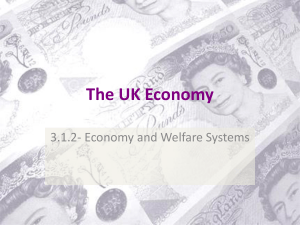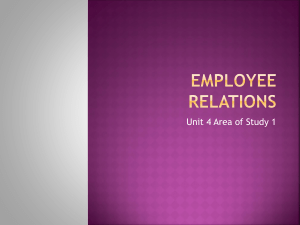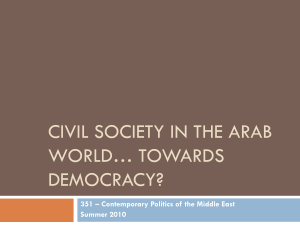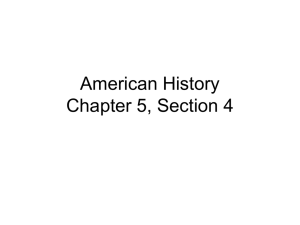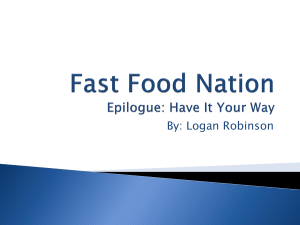Trade unions
advertisement
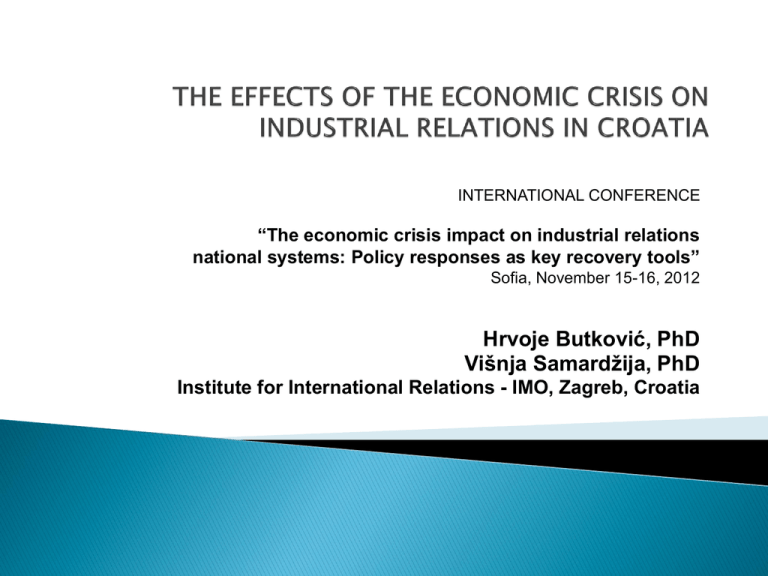
INTERNATIONAL CONFERENCE “The economic crisis impact on industrial relations national systems: Policy responses as key recovery tools” Sofia, November 15-16, 2012 Hrvoje Butković, PhD Višnja Samardžija, PhD Institute for International Relations - IMO, Zagreb, Croatia ECONOMIC CRISIS AND CHALLENGES OF SOCIAL DIALOGUE ◦ Economic framework ◦ Crisis as a challenge ◦ Towards finding solutions ◦ Key issues analysed in a study FRAMEWORK FOR INDUSTRIAL RELATIONS IN CROATIA ◦ Legal and policy framework ◦ Basic features of representative social partners ◦ Collective bargaining in Croatia LEGISLATIVE AND FISCAL CHANGES ◦ Law on representativeness ◦ Other legislative changes ◦ Fiscal changes ◦ Examples from the practice KEY FINDINGS AND RECOMENDATIONS Croatia strongly hit by economic crisis in 2009, continued recession underway, slow recovery expected Key issues: ◦ Continued economic decline, high level of public consumption, lack of investment, decreasing competitiveness, restructuring – new employment or deepening unemployment? Austerity measures, cuts in budget, wages in public sector, material rights in collective agreements Trade unions and employers associations - strong response to austerity measures Negotiations on collective agreement for public services Challenges of future EU membership Indicator 2008 2009 2010 2011 2012 prognosis -1.2 2013 prognosis 0.8 2.2 -6.0 -1.2 0.0 GDP per capita (EUR)2 10 722 10 111 10 394 10 427 - - General government balance (% GDP)1 -1.4 -4.1 -4.9 -5.0 -5.1 -5.0 General government gross debt (% GDP-a)1 28.7 35.0 41.2 45.7 51.3 57.1 External debt (% GDP)2 85.4 101.0 101.2 99.6 - - Average annual inflation growth (%)2 6.1 2.4 1.1 2.3 - - Unemployment rate (%)3 Employment rate (%)4 8.4 9.1 11.8 13.5 - - 57.8 56.6 54.0 52.4 - - 4 218 2 415 0 297 1 074 - - GDP, real annual growth rate (%)1 Foreign direct iinvestments (mil EUR)5 Government - Ensuring conditions for economic recovery and growth, preserving work places - Reducing public spending, increasing efficiency of public sector - Ensuring public sector development, maintaining social peace - Introducing order to payment system, diminishing illiquidity Employers - Amending the Labour law, with aim to facilitate flexibility and possibilities of employment - Obtaining the greatest possible tax reliefs - Diminishing the role of public sector in Croatian economy Trade unions - Preserving existing levels of salaries and employment - Maintaining rights from collective agreements - Strengthening trade unions on all levels Crisis as a challenge – new way of thinking, realistic approach! Completing structural reforms necessary Restructuring, reindustrialisation, reducing barriers to investment, management of human resources Labour market reform should be accelerated Social „peace” necessary – further increase of debt not possible Agreement between social partners should be achieved in a different way, considering economic potentials of the country Searching for different modalities of work and reaching agreements through social partnership Social dialogue - still not seen as a mechanism for reaching compromises between social partners and shaping public policies Positions of Government and other social partners differ significantly: public spending, reducing substantive rights in public sector. Rapprochement of standpoints on the ways for overcoming the crisis Trade unions are fragmented, not always sharing same views Fairly and equal distribution of austerity measures needed, finding solution within available financial possibilities Quality of social dialogue should be brought on higher level, building capacities and competencies of all social partners Analytical monitoring and recording indicators on industrial relations are not sufficiently developed Culture of argumentative dialogue should be strengthened Labor law (LL) ◦ enacted in 1995 and revised five times; ◦ industrial relations reviewed in five chapters; ◦ strike has to be announced; ◦ mediation process obligatory; ◦ dual system of workers representation Economic and Social Council (ESC) ◦ the highest form of tripartite social dialogue in Croatia; ◦ advisory body; ◦ national and the regional ESCs; ◦ permanent and temporary working bodies; ◦ in March 2011 the ESC was re-launched Established as Office for Social Partnership in December 2001 Changed to Independent Service for the Social Partnership in January 2012 Logistic and expert support for the social dialogue and partnership Coordinates work of the ESC Promotes sectoral social dialogue Intermediates in settlement of labour disputes Operates as the secretariat of the EU-Croatia Joint Consultative Committee Confederation/ Association Year of establishment Number of trade unions/employe rs Number of workers President Independent Trade Unions of (ITC) Union of Autonomous Trade Unions of (UATC) 1999 61 125,000 Krešimir Sever 1990 17 110,000 Mladen Novosel MATICA – Association of Croatian Trade Unions (MACT) 1993 10 64,000 Vilim Ribić Croatian Trade Union Association (CTA) Association of Workers’ Trade Unions of (AWTC) 1990 70 45,000 Ozren Matijašević 1994 45 24,000 Damir Jakuš 1993 6,000 400,000 Trade union associations Employers’ associations Croatian Employers’ Association (CEA) Ivica Mudrinić . 237 national trade unions, 534 trade unions 423 964 trade union members (35% coverage) Public sector (68%) Private sector (17%) Privatized companies (31%) New private sector companies (9%) Employers in numbers 24 higher confederations 52 employers’ associations Employers’ associations are mostly grouped by the sectors Croatian Employers’ Association (CEA) the only representative employers’ association in Croatia CEA operates in 3 regional offices and has 25 branch associations Negotiation with a bargaining committee Possibility of extending application of national collective agreement May 1st, 2012: total of 141 national collective agreements were in force in Croatia, 16 of which were branch agreements Five sectoral collective agreements were extended In 2010 the number of county collective agreements was 685 Collective agreement coverage is around 61%. 44% in private sector and nearly 100% in public (Bagić, 2010) Collective agreements don't properly express specific characteristics of branches and industries 2009 No CA were concluded 2010 ◦ BCA for public service officers ◦ CA for workers in secondary education ◦ CA for the private healthcare sector ◦ CA for science and higher education ◦ CA for workers in primary education 2011 ◦ CA for workers in primary education ◦ CA for workers in cultural institutions ◦ CA for the social welfare services ◦ CA for the security industry 2012 ◦ CA for the civil servants In the last two years four sectoral social councils have been established ◦ ◦ ◦ ◦ Textile – tripartite council Forestry and Wood Industry -tripartite Road Transport–bipartite Railroad Sector– bipartite Agreements specified actions to be taken by the social councils In many industries there are no branch unions or existing ones are weak compared to the in-house unions BCA for the Public Services set to expire in October 2013 Government started negotiations to change BCA in June 2012. Government proposed irreversible revocation of certain substantive rights in 2012 and 2013 ◦ Christmas bonuses ◦ vacation allowances ◦ anniversary bonuses Four trade unions accepted proposal, but four rejected it Mediation process with the four trade unions failed Government terminated the BCA in September 2012. The new BCA has been announced Law on the criteria for participation in the tripartite bodies and representativeness for collective bargaining (July 2012) Law limits extended application of collective agreements to a period of three months from their expiry Right of collective bargaining only to representative unions Representative union has at least 20% of employee members in the total number of unionized employees Employers’ associations Trade unions’ associations 1. At least six months in register 1. At least six months in the of higher level employers’ register of higher level trade associations. unions’ associations. 2. Membership of at least 3000 2. Affiliated trade unions have at employers, or affiliated with least 50 000members (workers). employers employing at least 100,000 workers. 3. Gather at least five employers’ 3. Gather at least five trade unions’ associations operating in different associations, operating in different areas. areas. 4. Have regional offices in at least 4. Have regional offices in at least four counties. four counties. 5. Have proper premises and other necessary material working conditions and employ at least five workers. 5. Have proper premises and other necessary material labour conditions and employ at least five workers. Law on promotion of employment (May 2012) ◦ Riddance from salary contribution (2 years) for employer hiring unemployed person without work experience ◦ State pays contributions for a highly educated young persons who can acquire a year of work experience this way ◦ For their work young people will receive atonement benefit of 1 600 HRK An annual tax on unused property in the amount 0.5% to 2% of the market property value to be re-established every year Labour Law changes ◦ better regulation of the part time work; ◦ abolishing sharp distinction between indeterminate and fixed term employment - a single employment contract Law on the special tax on salaries, pensions and other incomes ◦ 2%-4% of the net salary („crisis tax”) valid in 2009-2010 The Value Added Tax (VAT) ◦ From from 22% to 23% (2009) / from 23% to 25% (2012) The Increase of 20% to electricity and gas prices (May 2012) The Package of Tax Laws (2012) ◦ General Tax Law (publishing names of tax debtors) ◦ Directive preventing redemption of salaries without paying taxes ◦ Law on Income Tax (exempting all reinvested profits) ◦ Law on the Revenue Tax (increases non taxable salary base) ◦ Law on Contributions (health insurance 15 %to 13 %) - Rapprochement of standpoints on the ways for overcoming the crisis - parameters of the future economic development Fairly equal distribution of austerity measures needed Finding solution within available financial possibilities Labour market reform in Croatia should be accelerated Activities aimed at building the capacities and competencies of all social partners need to be intensified Solving the persisting problems in the industrial relations system: ◦ fragmentation of the union scene; ◦ reluctance of employers to accept unions as partners; ◦ insufficient CA coverage in the private sector, etc. Social partners should be given timely insight in Government's future intentions Social dialogue should be started at earlier stages Collective agreements should express particularities of the areas for which they are composed Frequency of using the instrument of extending provisions of CA to entire industry should be reduced More intensive work is needed on spreading the model of bipartite and sectoral social dialogue Regular collection and development of indicators for monitoring and evaluation of industrial relations Communication with the media should be improved A culture of argumentative dialogue between all participants should be strengthened Thank you! visnja.samardzija@irmo.hr butkovic@irmo.hr



